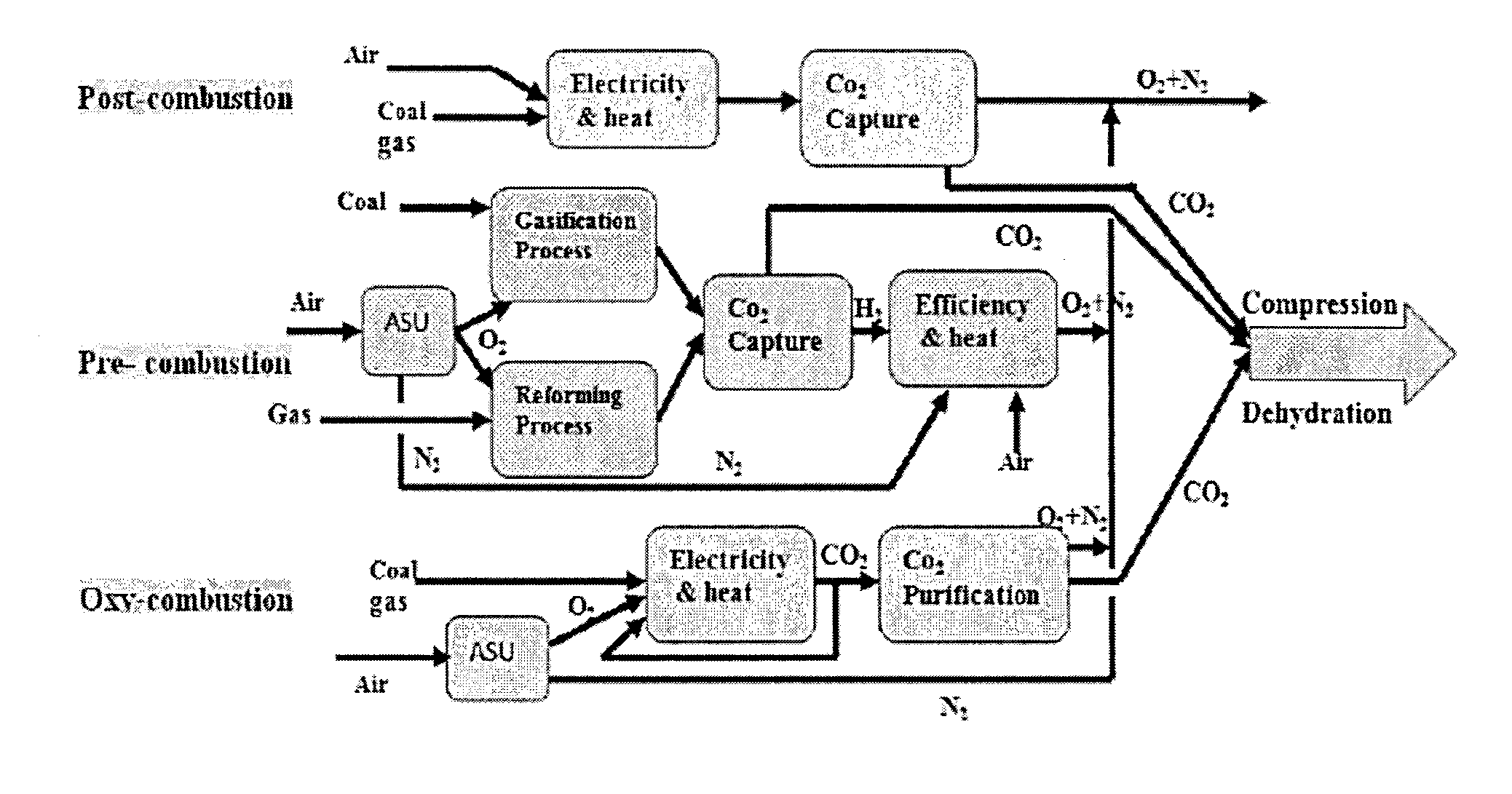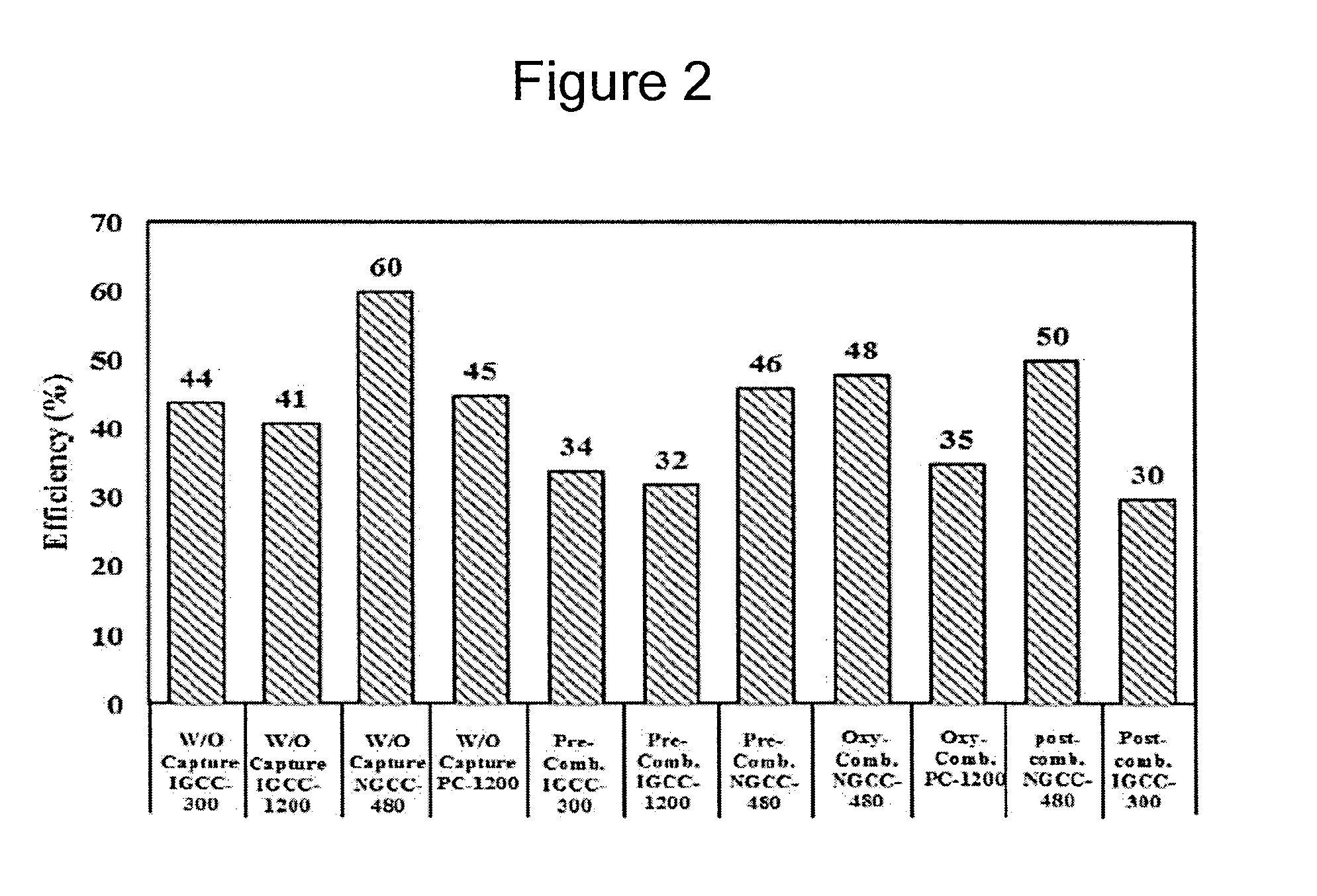Despite their complexity, commercial cryogenic units achieve low Second Law efficiencies in the range of 15-24%, resulting in a First Law efficiency loss of up to 8.5% points compared to a typical NGCC (
Natural gas combined cycle) without CCS.
Energy production from
fossil fuel combustion results in the emission of
greenhouse gases, the dominant contributor being CO2.
(7) As oxy-fuel combustion combined with sequestration must provide power to several significant unit operations, such as
flue gas compression, that are not required in a conventional
plant without sequestration, oxy-fuel combustion / sequestration is less efficient per unit of energy produced.
The combustion of fuel in a mixture of recirculated
flue gas (RFG) and
oxygen, however, presents new challenges to combustion specialists.
Several experimental investigations with oxy-firing pulverized
coal burners report that
flame temperature and stability are strongly affected.
This causes poor combustion performance and a modified distribution of temperature and species in the
combustion chamber.
The combustion of fuel in a mixture of recirculated
flue gas (RFG) and oxygen, however, presents new challenges to combustion specialists.
Several experimental investigations with oxy-firing pulverized
coal burners reported that flame temperature and stability are strongly affected.
This causes poor combustion performance and a modified distribution of temperature and species in the
combustion chamber.
However, CFD modeling of industrial combustion applications is a computationally demanding task.
It is necessary to apply simplified reaction mechanisms to reduce the computing cost and time; however the simplified schemes do not work as well under oxy-fuel combustion conditions like the case of combustion using air.
As temperatures at the compressor outlet are not sufficient to activate the membrane material's conduction mechanism, the air needs to be preheated with
counter current oxygen enriched
flue gas.
This in turn leads to lower
system efficiency and increased cost for separation.
Flame instability and poor
burnout have been experienced when oxygen / CO2 are premixed and supplied together to the flame as the oxidizer.
With high level oxygen in the oxidizer, the
combustion products become hot and this may lead to high level of oxygen in the
flue gas due to the dissociation reactions at high temperatures.
However, attempts of operating the burner with 2 were unsuccessful even with conditions of Φ=1 at 20 and 30 kW resulting in unstable operation and
blow out.
Under these conditions, the flames tend to exhibit undesired instabilities, e.g., in the form of unsteady flame stabilization or thermoacoustic oscillations.
The underlying mechanisms of the instabilities are based on the complex interaction between flow field, pressure, mixing, and chemical reactions, and are not well enough understood to date.
Detailed measurements in full-scale combustors are hardly possible, and very expensive and numerical tools have not yet reached a sufficient level of confidence to solve the problems.
Intrusive probe measurements are less suited for these applications as they disturb the local flow field and change the conditions for stabilization and for reaction—locally or even in general.
When the membrane has a thickness far less than the
critical thickness, Lc, the resistance by bulk
diffusion can be neglected; therefore, the surface exchange reaction becomes the rate-limiting step.
Li and Tan found that the LSCF hollow-
fiber module operated at elevated pressure may not be a good choice compared to the operation under vacuum conditions.
However, there is no improvement in oxygen
permeation flux with further decrease in the vacuum.
They concluded that the reduced thickness of the membrane has an enormous effect on oxygen
permeation flux as the ionic bulk
diffusion will be the
rate limiting step at high temperature.
However, two fundamental problems of employing steam or
water vapor are membrane stability and membrane module itself.
Tan et al. and Wang et al. did not explain these two problems due to the limitation of experimental apparatus.
The detailed mathematical formulation for oxygen permeation through mixed-conducting
ceramic membranes is fairly complex.
However, the increase in the inlet
inert gas amount has a complicated effect on the oxygen permeation flux because it lowers both oxygen
partial pressure and the
reaction rate at the same time.
Both the OCM and SOE reaction mechanisms are very complex and may involve over hundreds of steps.
However, it is limited in the sense that it applies for a specific
membrane thickness, and also cannot be extrapolated too far from the experimental conditions used to obtain the fitted values for A and B. The functional dependence on
partial pressure is assumed to be n=0.5 for LSCF, and n=0.25 for LNO based on global surface exchange
kinetics theory and experimental results and the values of A and B are 26.75 mol m−2 s−1 pa−n, 16510 K for LSCF and 2.011 mol m−2 s−1 pa−n, 10240 K for LNO respectively.
Although it is generally agreed that the driving force for oxygen permeation is the
oxygen potential gradient across the membrane, the oxygen
partial pressure, or oxygen
chemical potential in the reaction side is very difficult to define or measure by experiments.
Varying reactant flow rate may also cause a change in oxygen permeation mechanism leading to a complex permeation flux versus flow rate relationship.
Consequently,
excess oxygen ions recombined to form oxygen molecules, which caused serious combustion of
methane in the
gas phase and reduced the selectivity of the desired C2+ products.
 Login to View More
Login to View More  Login to View More
Login to View More 


